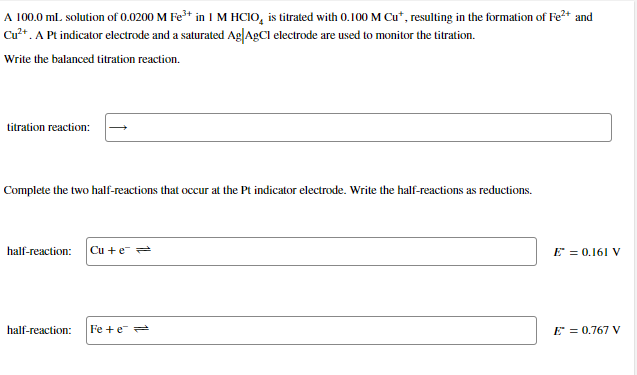A 100.0 ml. solution of 0.0200 M Fe³* in I M HCIO, is titrated with 0.100 M Cu*, resulting in the formation of Fe2* and Cu²*. A Pt indicator electrode and a saturated Ag|AgCl electrode are used to monitor the titration. Write the balanced titration reaction. titration reaction: Complete the two half-reactions that occur at the Pt indicator electrode. Write the half-reactions as reductions. half-reaction: Cu +e = E = 0.161 V half-reaction: Fe +e E = 0.767 V
A 100.0 ml. solution of 0.0200 M Fe³* in I M HCIO, is titrated with 0.100 M Cu*, resulting in the formation of Fe2* and Cu²*. A Pt indicator electrode and a saturated Ag|AgCl electrode are used to monitor the titration. Write the balanced titration reaction. titration reaction: Complete the two half-reactions that occur at the Pt indicator electrode. Write the half-reactions as reductions. half-reaction: Cu +e = E = 0.161 V half-reaction: Fe +e E = 0.767 V
Principles of Instrumental Analysis
7th Edition
ISBN:9781305577213
Author:Douglas A. Skoog, F. James Holler, Stanley R. Crouch
Publisher:Douglas A. Skoog, F. James Holler, Stanley R. Crouch
Chapter23: Potentiometry
Section: Chapter Questions
Problem 23.14QAP
Related questions
Question

Transcribed Image Text:A 100.0 ml. solution of 0.0200 M Fe* in I M HCIO, is titrated with 0.100 M Cu*, resulting in the formation of Fe* and
Cu*. A Pt indicator electrode and a saturated Ag|AgCl electrode are used to monitor the titration.
Write the balanced titration reaction.
titration reaction:
Complete the two half-reactions that occur at the Pt indicator electrode. Write the half-reactions as reductions.
half-reaction:
Cu + e
E = 0.161 V
half-reaction:
Fe +e =
E = 0.767 V
Expert Solution
This question has been solved!
Explore an expertly crafted, step-by-step solution for a thorough understanding of key concepts.
This is a popular solution!
Trending now
This is a popular solution!
Step by step
Solved in 2 steps

Knowledge Booster
Learn more about
Need a deep-dive on the concept behind this application? Look no further. Learn more about this topic, chemistry and related others by exploring similar questions and additional content below.Recommended textbooks for you

Principles of Instrumental Analysis
Chemistry
ISBN:
9781305577213
Author:
Douglas A. Skoog, F. James Holler, Stanley R. Crouch
Publisher:
Cengage Learning

Chemistry: The Molecular Science
Chemistry
ISBN:
9781285199047
Author:
John W. Moore, Conrad L. Stanitski
Publisher:
Cengage Learning


Principles of Instrumental Analysis
Chemistry
ISBN:
9781305577213
Author:
Douglas A. Skoog, F. James Holler, Stanley R. Crouch
Publisher:
Cengage Learning

Chemistry: The Molecular Science
Chemistry
ISBN:
9781285199047
Author:
John W. Moore, Conrad L. Stanitski
Publisher:
Cengage Learning
